Toxophilix
Bright Spark
Here is my take on my new PCS Inferno, aka Clevo W110ER.
Spec
Minus the obvious stuff, my spec is:
i7 3632QM
8GB RAM
750GB WD Scorpio HDD
GT-650M (standard)
11.6" 1366x768 matte screen (also standard).
When I saved the quote about three weeks ago this came to £640 (without an OS). I think the price has gone up by a few pounds since.
The 3632QM is essentially the same processor as the 3630, but slightly slower and slightly more expensive. If that seems a strange choice, there's a benefit which is that it's rated at 35W TDP rather than 45W. That, in turn, means that the whole laptop will run off a 90W power supply rather than the 120W that the 3630 would require. You might also hope that the 3632 would generate a bit less heat. We'll see.
I went for the HDD over an SSD purely because I wanted at least half a terabyte of space and a 480GM SSD would have taken the price close to £1,000, which was quite a lot more than I was willing to pay.
Appearance
Reviews of the W110ER often comment on how it looks like a netbook but can hold the internals of a MacBook Pro. Now that I have one in my hands I would actually dispute the first part of that. Though it is as thick as a netbook, the Inferno doesn't really resemble one. For one thing it's bigger - 11.6" as opposed to the 10.1 that is typical of netbooks. Then again, its unbadged, dark-grey matte finish gives it a "stealth" look that I find quite appealing. I'd even say that I'm finding it a refreshing change from the regiments of wafer-thin silvery-blue laptops.
People often ask on the forum about the build quality of the Clevo laptops. The casing here is made entirely of plastic and seems to be formed from just a few molded parts. Some of it has a smooth, hard facing while other areas have a dimpled finish that feels slightly rubbery. I think it's hard to separate in one's mind the suspicion that something "feels cheap" from the knowledge that it is cheap however, trying to be objective about it, the Inferno does have a slightly cheap feel. It doesn't feel particularly fragile but I think it will need to be treated with a lot more care than a Thinkpad (but then again, it's half the cost or less).
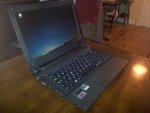
Screen
Moving onto the experience of actually using the machine, the first thing to comment on is the screen. It's actually pretty good. I'm typing this while sitting next to the window on a train in the middle of the morning and everything is very clear on the matte panel (it is an overcast day, of course). The horizontal viewing angle extends to about 45 degrees from square so you could use the machine to show something to one or two people sitting next to you. However, the vertical viewing angle is limited. Someone standing next to you won't be able to see your screen clearly if you are working seated. (Actually, "bad" viewing angles seem like a plus to me because I don't particularly want my screen to be easily read by all and sundry, but if you're showing a presentation then this stuff matters, of course.)
The 1366 x 768 resolution actually looks quite sharp at at this size - at least to my eye it does, but then it has more pixels to the inch than my desktop monitor.
Keyboard
The keyboard is a pleasant surprise to me. It's chiclet-style and, obviously, small. I was expecting to find it cramped and difficult to use and last night I was having trouble locating the left-shift key. Overnight, however, I seem to have got used to it and this morning I'm touch-typing with no trouble and without giving it a thought, so it really can't be that bad. The action is a bit soft and mushy but, for a device of this size, this is not a bad keyboard.
Trackpad
The trackpad has a somewhat rough finish - the same finish as the screen-back and keyboard-surround, in fact. I'm used to a smooth trackpad and found this one to be a bit sticky at first. Again, though, I've been using it this morning without noticing it so I would say it's fine.
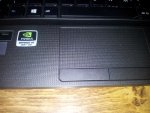
Speakers
The speakers are serviceable, nothing special but adequate for gaming and watching video. I wouldn't choose to listen to music through them.
Battery life
All reviews of the W110ER agree that the battery life is not brilliant. Using Linux, I'm currently on course for 3.5 hours total life while writing this review (which, let's be honest, is very light use). That said, I haven't taken any power-saving measures others than to turn off wifi.
Battery life while gaming is worse still. In 15 minutes of Far Cry 3 I used 20% of the battery, so on course for 75 minutes. Ultimately, though, I think we all accept that you won't be able to run the most demanding games on battery for very long. I think it's the non-gaming battery life that will be a problem for some users.
90W Power Adaptor
As mentioned, the use of a 35W CPU allows you to choose a 90W power adaptor. That was my preference because I intend to use this machine while travelling and the idea of a small, light laptop with a large power-brick didn't appeal. I'm pleased to say that the 90W adaptor really isn't that big. It's not the dinky little thing you get with a real netbook, but it's not a monster either and doesn't compromise the light and portable characteristics of the laptop.
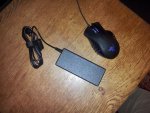
Heat
Another thing that all W110ER reviews seem to agree on is that it idles at a high temperature. 60 degrees for the CPU is widely quoted. I've been seeing about 57 degrees which might indicate that the 3632QM runs a little cooler than the 3630 or 3740 which seem to have been installed in most of the reviewed specs. Or it could be that that's nonsense and it's just the case that these measurements, as reporting by monitoring software, are not very accurate.
You might think that if a computer idles at 57C then it will vaporize if you put it under load but with the Inferno it's not so. Under load the temperature goes up, but only to the level you would normally expect. The highest CPU temperature I've reached is 81C while playing Shogun 2 Total War.
By the way, temperatures for the Nvidia GPU and the CPU seem to be somewhat related in this machine, presumably because they share a single heatsink. Thus, while idling, when the GT-650M is doing nothing (because we are using the Intel graphics), the GPU reaches a temperature of 50C. Again, however, there doesn't seem to be a problem with peak temperatures: in games the highest GPU temperature I've seen so far was 83C in Far Cry 3. No doubt that will be exceeded in future, but there's a fair amount of headroom between that and meltdown.
One thing to mention about heat is that the underside of the case, the keyboard and its surround do not get above lukewarm even in prolonged use. Consequently, it's perfectly comfortable to use this machine on your lap. Indeed it's among the cooler laptops I've used from that point of view. The concern about the idle temperatures is purely to do with what effect it may have on the machine itself, over time. To strike an optimistic note, there don't seem to be a lot of reports of W110ERs actually breaking down through overheating, although floking96 (https://www.pcspecialist.co.uk/forums/showthread.php?23490-Where-do-I-stand-on-a-refund) seems to have had heat-related issues with his Inferno.
Noise
Another unexpected plus of this machine is that it's relatively quiet. During general use, surfing etc it's actually silent (which I guess is part of the reason it's so hot). While gaming the fan spins up but, while distinctly audible, it's not what I'd call loud.
Performance
The two most demanding games that I've played so far, both already mentioned, are Shogun 2 and Far Cry 3. In Shogun 2 I got 45 FPS on near Ultra settings in large-scale battles. With Far Cry 3 I got 30+ FPS on High and 40+ on Medium.
3dmark11 'Performance' was 2384 which is in the mid/upper range of scores that notebookcheck have for i7/650M-equipped laptops. (Amusingly it's actually the exact same score they have for the MacBook Pro 15".) Btw, in case anyone wonders, there was no significant variation in score between the Nvidia driver bundled on the CD and the current 314.07.
Boot times:
Windows 7: 39 seconds
Linux Mint 14 (Cinnamon): 29 seconds
These would be improved by an SSD, of course.
A note about Linux install
Installing Linux Mint 14 Cinnamon alongside Windows 7 was a breeze. This being an Optimus machine, I knew that I would need Bumblebee and I was prepared for some hassle with that, but in reality it was as simple as adding a couple of repositories and installing it with apt-get. I haven't tried to run any games with Bumblebee yet but in the glxspheres test I get 150% improvement running with optirun (ie, using the Nvidia card) over running with Intel graphics. So it's doing something
In case anyone is wondering, I had absolutely no BIOS/UEFI related issues with dual-booting this machine. The only time I touched the BIOS was to choose the USB as boot device.
Summary
I chose the Inferno over similarly priced laptops because it sounded interesting, characterful and ever so slightly insane: an i7 CPU and a decent GPU in a netbook etc. In reality, it's actually a lot better than that. It doesn't really look like a netbook and in use it doesn't feel like one. It's highly mobile - I carried it everywhere with me yesterday and worked on this review in odd minutes here and there - and it's seriously powerful - you can install a whole Steam library on it and know that you have the CPU and GPU to play any current game. Putting those qualities together, it's a very nice small computer indeed.
The Inferno next to a real netbook. As different as night and day.
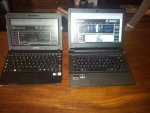
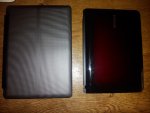
Spec
Minus the obvious stuff, my spec is:
i7 3632QM
8GB RAM
750GB WD Scorpio HDD
GT-650M (standard)
11.6" 1366x768 matte screen (also standard).
When I saved the quote about three weeks ago this came to £640 (without an OS). I think the price has gone up by a few pounds since.
The 3632QM is essentially the same processor as the 3630, but slightly slower and slightly more expensive. If that seems a strange choice, there's a benefit which is that it's rated at 35W TDP rather than 45W. That, in turn, means that the whole laptop will run off a 90W power supply rather than the 120W that the 3630 would require. You might also hope that the 3632 would generate a bit less heat. We'll see.
I went for the HDD over an SSD purely because I wanted at least half a terabyte of space and a 480GM SSD would have taken the price close to £1,000, which was quite a lot more than I was willing to pay.
Appearance
Reviews of the W110ER often comment on how it looks like a netbook but can hold the internals of a MacBook Pro. Now that I have one in my hands I would actually dispute the first part of that. Though it is as thick as a netbook, the Inferno doesn't really resemble one. For one thing it's bigger - 11.6" as opposed to the 10.1 that is typical of netbooks. Then again, its unbadged, dark-grey matte finish gives it a "stealth" look that I find quite appealing. I'd even say that I'm finding it a refreshing change from the regiments of wafer-thin silvery-blue laptops.
People often ask on the forum about the build quality of the Clevo laptops. The casing here is made entirely of plastic and seems to be formed from just a few molded parts. Some of it has a smooth, hard facing while other areas have a dimpled finish that feels slightly rubbery. I think it's hard to separate in one's mind the suspicion that something "feels cheap" from the knowledge that it is cheap however, trying to be objective about it, the Inferno does have a slightly cheap feel. It doesn't feel particularly fragile but I think it will need to be treated with a lot more care than a Thinkpad (but then again, it's half the cost or less).

Screen
Moving onto the experience of actually using the machine, the first thing to comment on is the screen. It's actually pretty good. I'm typing this while sitting next to the window on a train in the middle of the morning and everything is very clear on the matte panel (it is an overcast day, of course). The horizontal viewing angle extends to about 45 degrees from square so you could use the machine to show something to one or two people sitting next to you. However, the vertical viewing angle is limited. Someone standing next to you won't be able to see your screen clearly if you are working seated. (Actually, "bad" viewing angles seem like a plus to me because I don't particularly want my screen to be easily read by all and sundry, but if you're showing a presentation then this stuff matters, of course.)
The 1366 x 768 resolution actually looks quite sharp at at this size - at least to my eye it does, but then it has more pixels to the inch than my desktop monitor.
Keyboard
The keyboard is a pleasant surprise to me. It's chiclet-style and, obviously, small. I was expecting to find it cramped and difficult to use and last night I was having trouble locating the left-shift key. Overnight, however, I seem to have got used to it and this morning I'm touch-typing with no trouble and without giving it a thought, so it really can't be that bad. The action is a bit soft and mushy but, for a device of this size, this is not a bad keyboard.
Trackpad
The trackpad has a somewhat rough finish - the same finish as the screen-back and keyboard-surround, in fact. I'm used to a smooth trackpad and found this one to be a bit sticky at first. Again, though, I've been using it this morning without noticing it so I would say it's fine.

Speakers
The speakers are serviceable, nothing special but adequate for gaming and watching video. I wouldn't choose to listen to music through them.
Battery life
All reviews of the W110ER agree that the battery life is not brilliant. Using Linux, I'm currently on course for 3.5 hours total life while writing this review (which, let's be honest, is very light use). That said, I haven't taken any power-saving measures others than to turn off wifi.
Battery life while gaming is worse still. In 15 minutes of Far Cry 3 I used 20% of the battery, so on course for 75 minutes. Ultimately, though, I think we all accept that you won't be able to run the most demanding games on battery for very long. I think it's the non-gaming battery life that will be a problem for some users.
90W Power Adaptor
As mentioned, the use of a 35W CPU allows you to choose a 90W power adaptor. That was my preference because I intend to use this machine while travelling and the idea of a small, light laptop with a large power-brick didn't appeal. I'm pleased to say that the 90W adaptor really isn't that big. It's not the dinky little thing you get with a real netbook, but it's not a monster either and doesn't compromise the light and portable characteristics of the laptop.

Heat
Another thing that all W110ER reviews seem to agree on is that it idles at a high temperature. 60 degrees for the CPU is widely quoted. I've been seeing about 57 degrees which might indicate that the 3632QM runs a little cooler than the 3630 or 3740 which seem to have been installed in most of the reviewed specs. Or it could be that that's nonsense and it's just the case that these measurements, as reporting by monitoring software, are not very accurate.
You might think that if a computer idles at 57C then it will vaporize if you put it under load but with the Inferno it's not so. Under load the temperature goes up, but only to the level you would normally expect. The highest CPU temperature I've reached is 81C while playing Shogun 2 Total War.
By the way, temperatures for the Nvidia GPU and the CPU seem to be somewhat related in this machine, presumably because they share a single heatsink. Thus, while idling, when the GT-650M is doing nothing (because we are using the Intel graphics), the GPU reaches a temperature of 50C. Again, however, there doesn't seem to be a problem with peak temperatures: in games the highest GPU temperature I've seen so far was 83C in Far Cry 3. No doubt that will be exceeded in future, but there's a fair amount of headroom between that and meltdown.
One thing to mention about heat is that the underside of the case, the keyboard and its surround do not get above lukewarm even in prolonged use. Consequently, it's perfectly comfortable to use this machine on your lap. Indeed it's among the cooler laptops I've used from that point of view. The concern about the idle temperatures is purely to do with what effect it may have on the machine itself, over time. To strike an optimistic note, there don't seem to be a lot of reports of W110ERs actually breaking down through overheating, although floking96 (https://www.pcspecialist.co.uk/forums/showthread.php?23490-Where-do-I-stand-on-a-refund) seems to have had heat-related issues with his Inferno.
Noise
Another unexpected plus of this machine is that it's relatively quiet. During general use, surfing etc it's actually silent (which I guess is part of the reason it's so hot). While gaming the fan spins up but, while distinctly audible, it's not what I'd call loud.
Performance
The two most demanding games that I've played so far, both already mentioned, are Shogun 2 and Far Cry 3. In Shogun 2 I got 45 FPS on near Ultra settings in large-scale battles. With Far Cry 3 I got 30+ FPS on High and 40+ on Medium.
3dmark11 'Performance' was 2384 which is in the mid/upper range of scores that notebookcheck have for i7/650M-equipped laptops. (Amusingly it's actually the exact same score they have for the MacBook Pro 15".) Btw, in case anyone wonders, there was no significant variation in score between the Nvidia driver bundled on the CD and the current 314.07.
Boot times:
Windows 7: 39 seconds
Linux Mint 14 (Cinnamon): 29 seconds
These would be improved by an SSD, of course.
A note about Linux install
Installing Linux Mint 14 Cinnamon alongside Windows 7 was a breeze. This being an Optimus machine, I knew that I would need Bumblebee and I was prepared for some hassle with that, but in reality it was as simple as adding a couple of repositories and installing it with apt-get. I haven't tried to run any games with Bumblebee yet but in the glxspheres test I get 150% improvement running with optirun (ie, using the Nvidia card) over running with Intel graphics. So it's doing something
In case anyone is wondering, I had absolutely no BIOS/UEFI related issues with dual-booting this machine. The only time I touched the BIOS was to choose the USB as boot device.
Summary
I chose the Inferno over similarly priced laptops because it sounded interesting, characterful and ever so slightly insane: an i7 CPU and a decent GPU in a netbook etc. In reality, it's actually a lot better than that. It doesn't really look like a netbook and in use it doesn't feel like one. It's highly mobile - I carried it everywhere with me yesterday and worked on this review in odd minutes here and there - and it's seriously powerful - you can install a whole Steam library on it and know that you have the CPU and GPU to play any current game. Putting those qualities together, it's a very nice small computer indeed.
The Inferno next to a real netbook. As different as night and day.


